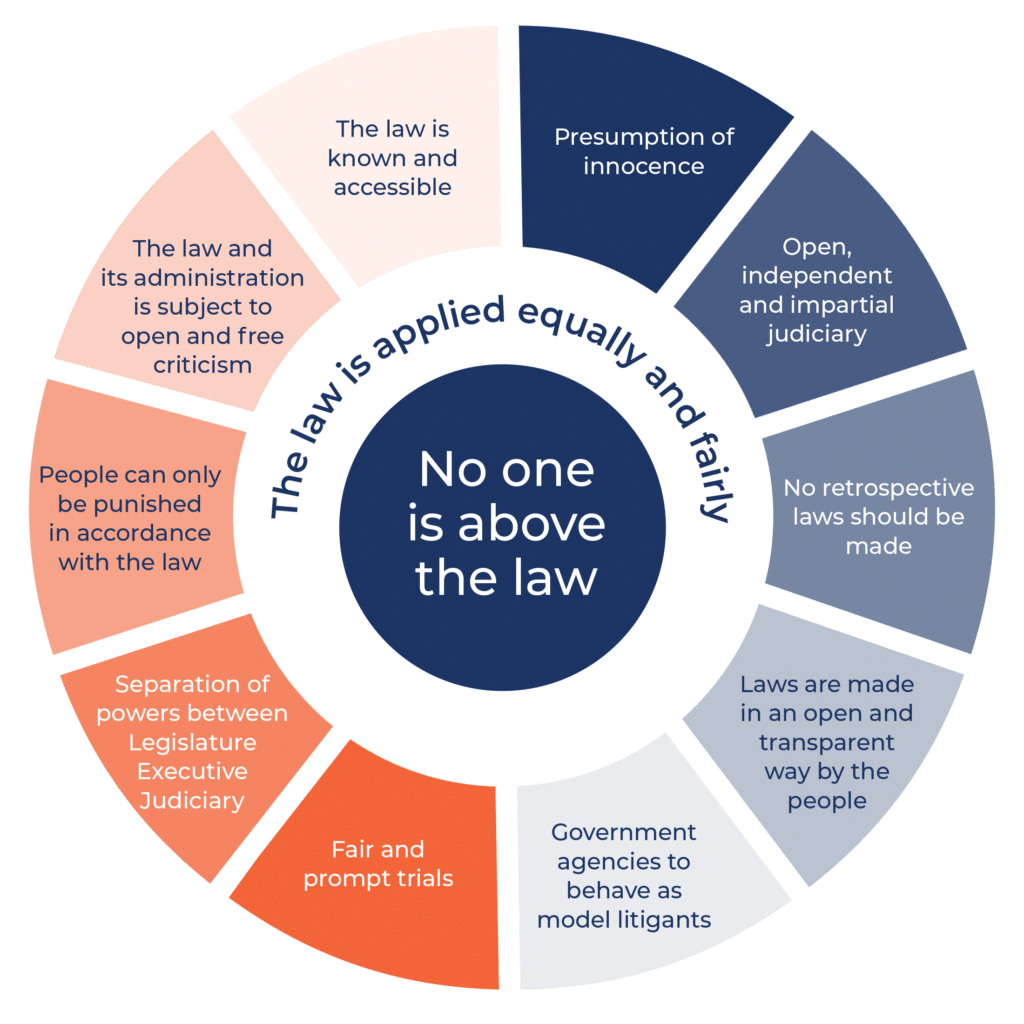Beyond Reasonable Doubt
In this article we explore jury directions, the meaning of “beyond a reasonable doubt” and onus of proof.
The presumption of innocence is an important part of any fair criminal justice system under the rule of law. The clearest way we protect the presumption of innocence in our system is through the high standard of proof placed on the prosecution in a criminal trial: that they must prove the case against the accused “beyond reasonable doubt”.
However, that protection rings less true, or seems less sure, when the content of the phrase is subject to such widely different interpretations and applications.
This article will explore two elements of beyond reasonable doubt:
1. how jury directions about the presumption of innocence relate to the rule of law through a case study from Victoria: Dookheea.
2. the onus of proof on the prosecution to prove beyond reasonable doubt (and not possible doubt) through a case study: Pell
Jury directions
At the end of a trial with a jury, after all the evidence has been put before the jury, and after the prosecution and defence have given their closing statements, the judge will sum up the case for the jury. They will review the evidence and arguments made by both sides, and frame the legal principles on which the jury has to make its decision. These remarks from the judge are known as “jury directions”.
Jury directions have become more and more frequent as the criminal process has developed over the generations. Before the trial system we have today emerged in Great Britain during the eighteenth century:
The judge enjoyed a supervisory role, leading what was a largely unstructured discussion with jurors, witnesses, the accused and the alleged victim. Judges had an unrestricted power to comment to the jury on the evidence and the merits of the case as they worked together to elicit evidence.
That ‘unstructured discussion’ gradually evolved into the adversarial system we have today, where:
Presentation of the cases for the prosecution and the defence became the responsibility of counsel through their examination and cross-examination of witnesses. A system of evidentiary laws developed to accommodate and regulate this process, and the power of the judge and the jury to gather evidence themselves was severely restricted. There developed the notion that the jury was independent of the judge and that its verdict and its deliberations leading to the verdict were inscrutable.
As the jury developed this new independent role, jury directions developed alongside:
to redress, as well as prevent, jury error in carrying out that role.
The New South Wales Law Reform Commission explained the purpose of jury directions as follows:
The system of jury directions continues to operate according to a basic premise that jurors will have difficulty in fulfilling their responsibilities without appropriate guidance from the judge. Jury directions aim to help jurors carry out their role of deciding issues of fact in the light of the applicable principles of law. They are intended to focus jurors’ minds on the real issues of the case. They seek to prevent jurors from basing a decision on facts that have not been admitted into evidence, or from considering evidence for a purpose other than the purpose for which it was admitted. In doing so, jury directions serve the larger purpose of ensuring a fair trial or, to put it differently, of avoiding any “perceptible risk of miscarriage of justice”.
Beyond a reasonable doubt
One of the key directions given to juries in criminal trials across Australia is to remind them of the accused’s right to be presumed innocent of the charge, and only to be convicted if the jury has been persuaded “beyond a reasonable doubt”. This crucial direction is just the latest protection given to the presumption of innocence, a concept that goes back through criminal law systems around the world for centuries, and which was famously described as the “golden thread” that runs through the common law system.
The only problem with the direction is that it is not always clear what is meant by a ‘reasonable doubt’.
Clearly, not every doubt is reasonable. In our system, the prosecution is not required to prove the guilt of the accused “beyond any possible doubt”. Raising the standard of proof to that level would make it nearly impossible to secure a conviction, and would prevent society from being able to police criminal behaviour.
On the other hand, lowering the standard of proof for the prosecution would remove important protections for the accused. Our society has decided that individual liberty is so important, and the shame and treatment associated with criminal liability so powerful, that we will require juries to be convinced to a particular standard before they find an accused guilty of a charge.
So, the question is, what is that particular standard?
The NSW Bureau of Crime Statistics and Research conducted a study in 2008 on what people understood by the phrase “beyond reasonable doubt”. They surveyed 1200 people who had been jurors in criminal trials across the state. The results are important:
55.4% of the jurors believed that the phrase meant that they needed to be “sure” that the person was guilty
22.9% believed it meant “almost sure”;
11.6% believed it meant “very likely”; and
10.1% believed it meant “pretty likely”.
As BOCSAR’s report wryly noted:
That is quite a wide spread of opinion.
The report also suggested that some clarification ought to be given to juries on what the phrase meant. A jury direction would be the obvious way of providing this clarification.
However, under current law in Australia – guided by the High Court’s decision in Green v R (1971) 126 CLR 28 – judges are not supposed to give juries any clarification. The phrase “beyond a reasonable doubt” is not to be explained beyond its’ words. As the Court said in Green, judges should:
adhere to and not to attempt needless explanations of the classical statement of the nature of the onus of proof resting on the Crown.
The only guidance provided by the Court as to the meaning of the phrase was:
A reasonable doubt is a doubt which the particular jury entertain in the circumstances. Jurymen themselves set the standard of what is reasonable in the circumstances.
The case of Dookheea
This brings us to the Victorian case of Dookheea. Mr Dookheea and his wife were charged over the death of their employer, Mr Zazai, who they were alleged to have beaten and then strangled to death.
A jury in the Victorian Supreme Court convicted Mr Dookheea of murder, but he appealed his conviction on the ground that the judge made an error in directing the jury. In summing up at the end of that trial, the judge said:
The question you have to ask yourselves is ‘has the Crown established beyond reasonable doubt that at the time Mr Dookheea committed the relevant act or acts that caused Mr Zazai’s death, he intended to kill Mr Zazai or cause him really serious injury?’ As a corollary you might ask, ‘do I hold a reasonable doubt that at the time he committed the relevant act or acts that caused Mr Zazai’s death, Mr Dookheea intended to kill Mr Zazai or cause him really serious injury?’ In other words, you do not have to work out definitively what Mr Dookheea’s state of mind was when he caused the injuries that killed Mr Zazai. You have to consider whether the Crown has satisfied you that Mr Dookheea had the intention that is required. And the Crown has to have satisfied you of this not beyond any doubt, but beyond reasonable doubt.
The final sentence above – “not beyond any doubt, but beyond reasonable doubt” – was held by the Victorian Court of Appeal to suggest to jurors that they may entertain a doubt, which is not a ‘reasonable doubt’, and on that basis proceed to convict the accused. This was held to be an error by the trial judge. Mr Dookheea’s conviction was set aside, and a retrial was ordered. The case was appealed to the High Court, where the High Court found that in accordance with Green, it is both unnecessary and unwise for a trial judge to attempt to explain what is meant by ‘beyond a reasonable doubt.’ However, the High Court concluded that while it may be unnecessary and unwise for a trial judge to contrast reasonable doubt with any doubt, it would not always result in a substantial miscarriage of justice. In Dookheea, the High Court found that a substantial miscarriage of justice had not occurred because
“There can be no doubt that the jury would have clearly understood it was up to them to decide whether there was what they considered to be a reasonable doubt as to Dookheea guilt and that, if there were, they were bound to acquit him”.
Dookhhea appeal was dismissed and the original sentence reinstated.
The case of Pell
This brings us to the recent Victorian case of Pell. Cardinal Pell was charged with historical child sexual abuse in the Victorian County Court, he then appealed to the Victorian Court of Appeal and finally to the High Court of Australia on the grounds that a reasonable jury, on the evidence, ought to have had a reasonable doubt as to Pell’s guilt.
A Case summary of the Pell High Court Judgement has been prepared.
Unanimously, the High Court of Australia allowed Pell’s appeal and quashed his convictions. The High Court of Australia overturned Pell’s convictions because they concluded that on the evidence, there was reasonable doubt as to Pell’s guilt and therefore a significant possibility that an innocent person had been convicted.
The High Court said the Court of Appeal had correctly stated the standard and burden of proof for the prosecution to eliminate all reasonable doubt. However, their reasoning and the process they adopted to arrive at their decision reversed this and required Pell to prove the offending was impossible.
The High Court judgement stated (emphasis added):
The Court of Appeal majority noted that defence counsel made the submission in his closing address that A’s account could not be accepted because “it’s impossible basically”, there having been no opportunity for the events to have occurred in the way that A described. In their Honours’ view, the submission made it incumbent upon the prosecution to seek to negative that the offending was impossible by demonstrating that there was a realistic opportunity for the offending to have occurred. While their Honours acknowledged that there was no onus upon the applicant to prove impossibility, their Honours’ analysis proceeded by asking, in relation to each piece of evidence that was inconsistent with A’s account, whether it was nonetheless realistically possible that that account was true.
As Weinberg JA noted, defence counsel’s choice to employ the language of impossibility in his closing address risked setting a forensic hurdle that the defence did not need to overcome. Regardless of counsel’s rhetorical flourish, the issue was whether the prosecution had excluded the reasonable possibility that the applicant did not commit the offence/s.
The High Court concluded by saying:
Making full allowance for the advantages enjoyed by the jury, there is a significant possibility in relation to charges one to four that an innocent person has been convicted.
The High Court judgement confirmed the key rule of law principle of presumption of innocence. That is, the prosecution is not required to prove the guilt of the accused “beyond any possible doubt” but beyond reasonable doubt.
The rule of law
The principle of equality before the law, not to mention the presumption of innocence, begins to be undermined when two people may face trial for similar offences according to quite different standards. All people, no matter their rank or importance must be treated equally under the law and must be presumed innocent until the prosecution has proved guilt beyond reasonable doubt.
The hard line taken by superior courts in Australia with regards to explaining the content of the phrase “beyond reasonable doubt” is rooted in an attempt to maintain the integrity of jury decision-making, and not overcomplicate an already complex process.
In recent years there have been attempts to ensure that jury directions are clear, brief, simple and compressible as possible. Victoria introduced legislation that specifically addresses jury directions in 2015. New South Wales also provides jurors with “Welcome to Jury Service” booklets, which aim to assist jurors in understanding their duties and responsibilities.
However, the refusal to look beyond the ‘magic phrase’ may have significant rule of law costs as well. The protection afforded by the presumption of innocence rings less true, or seems less sure, when the content of the phrase is subject to such widely different interpretations.
Further reading
‘Jury Directions‘, a May 2009 report from the Victorian Law Reform Commission
‘Jury Directions‘, November 2012 report from the NSW Law Reform Commission
Green v R, a 1971 High Court decision about jury directions
Dookheea v R, the 2016 Victorian Court of Appeal decision
Pell v Queen, 2020 High Court Australia
‘Suggested summing-up format‘, from the NSW Judicial Commission’s ‘Criminal Trial Courts Bench Book’
Teaching Guide
A. Basic Principles
- What are the key principles of the rule of law?
- Explain the principle of presumption of innocence.
B. Jury Directions
- At what point in the criminal trial process does the judge sum up the case and give the jury directions?
- What did the ‘unstructured discussion’ of courtrooms before the eighteenth century evolve into?
- What is the purpose of jury directions?
- What is a key direction that judges give juries in criminal trials?
- What did most jurors in the BOCSAR study think “beyond reasonable doubt” means?
- Explain how the judge is limited when defining the meaning of ‘beyond reasonable doubt’.
- Why was a retrial ordered in Dookheea?
C. Possible v Reasonable Doubt
- What is the standard of proof that the prosecution is required to prove in a criminal trial?
- What is required of the prosecution and defence if the onus of proof is reversed and the accused is presumed guilty?
D. Further Discussions
1. Discuss whether having a strict definition of “beyond reasonable doubt” would be effective in achieving just outcomes.
2. In your own words explain what a “beyond reasonable doubt” means to you
3. In Pell’s case, “the compounding improbabilities caused by the unchallenged evidence required the jury, acting rationally, to have entertained a doubt as to the applicants guilt.” Why are these factors relevant in ascertaining reasonable doubt?



